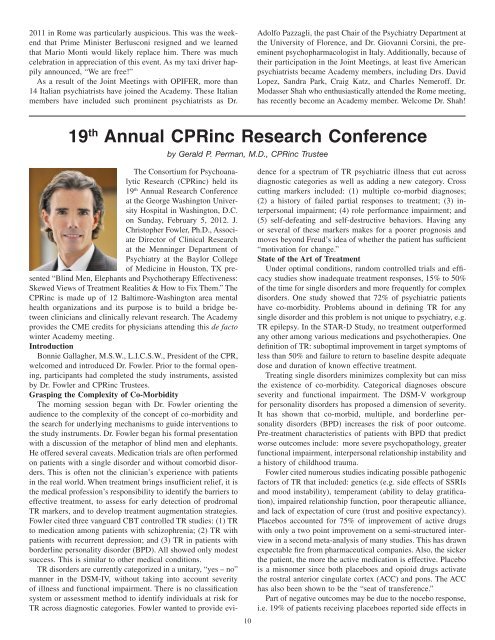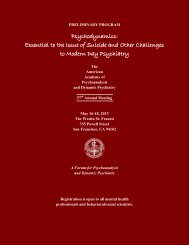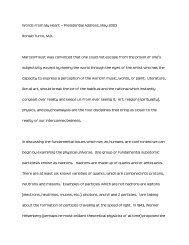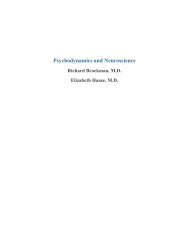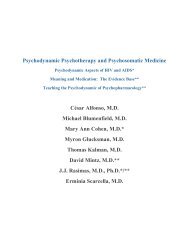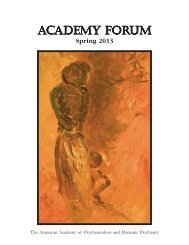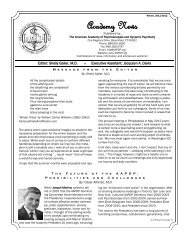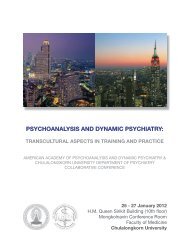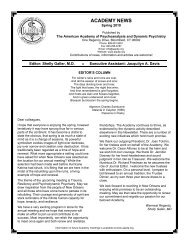ACADEMY FORUM - The American Academy of Psychoanalysis and Dynamic ...
ACADEMY FORUM - The American Academy of Psychoanalysis and Dynamic ...
ACADEMY FORUM - The American Academy of Psychoanalysis and Dynamic ...
You also want an ePaper? Increase the reach of your titles
YUMPU automatically turns print PDFs into web optimized ePapers that Google loves.
2011 in Rome was particularly auspicious. This was the weekend<br />
that Prime Minister Berlusconi resigned <strong>and</strong> we learned<br />
that Mario Monti would likely replace him. <strong>The</strong>re was much<br />
celebration in appreciation <strong>of</strong> this event. As my taxi driver happily<br />
announced, “We are free!”<br />
As a result <strong>of</strong> the Joint Meetings with OPIFER, more than<br />
14 Italian psychiatrists have joined the <strong>Academy</strong>. <strong>The</strong>se Italian<br />
members have included such prominent psychiatrists as Dr.<br />
Adolfo Pazzagli, the past Chair <strong>of</strong> the Psychiatry Department at<br />
the University <strong>of</strong> Florence, <strong>and</strong> Dr. Giovanni Corsini, the preeminent<br />
psychopharmacologist in Italy. Additionally, because <strong>of</strong><br />
their participation in the Joint Meetings, at least five <strong>American</strong><br />
psychiatrists became <strong>Academy</strong> members, including Drs. David<br />
Lopez, S<strong>and</strong>ra Park, Craig Katz, <strong>and</strong> Charles Nemer<strong>of</strong>f. Dr.<br />
Modasser Shah who enthusiastically attended the Rome meeting,<br />
has recently become an <strong>Academy</strong> member. Welcome Dr. Shah!<br />
19 th Annual CPRinc Research Conference<br />
by Gerald P. Perman, M.D., CPRinc Trustee<br />
10<br />
<strong>The</strong> Consortium for Psychoanalytic<br />
Research (CPRinc) held its<br />
19 th Annual Research Conference<br />
at the George Washington University<br />
Hospital in Washington, D.C.<br />
on Sunday, February 5, 2012. J.<br />
Christopher Fowler, Ph.D., Associate<br />
Director <strong>of</strong> Clinical Research<br />
at the Menninger Department <strong>of</strong><br />
Psychiatry at the Baylor College<br />
<strong>of</strong> Medicine in Houston, TX presented<br />
“Blind Men, Elephants <strong>and</strong> Psychotherapy Effectiveness:<br />
Skewed Views <strong>of</strong> Treatment Realities & How to Fix <strong>The</strong>m.” <strong>The</strong><br />
CPRinc is made up <strong>of</strong> 12 Baltimore-Washington area mental<br />
health organizations <strong>and</strong> its purpose is to build a bridge between<br />
clinicians <strong>and</strong> clinically relevant research. <strong>The</strong> <strong>Academy</strong><br />
provides the CME credits for physicians attending this de facto<br />
winter <strong>Academy</strong> meeting.<br />
Introduction<br />
Bonnie Gallagher, M.S.W., L.I.C.S.W., President <strong>of</strong> the CPR,<br />
welcomed <strong>and</strong> introduced Dr. Fowler. Prior to the formal opening,<br />
participants had completed the study instruments, assisted<br />
by Dr. Fowler <strong>and</strong> CPRinc Trustees.<br />
Grasping the Complexity <strong>of</strong> Co-Morbidity<br />
<strong>The</strong> morning session began with Dr. Fowler orienting the<br />
audience to the complexity <strong>of</strong> the concept <strong>of</strong> co-morbidity <strong>and</strong><br />
the search for underlying mechanisms to guide interventions to<br />
the study instruments. Dr. Fowler began his formal presentation<br />
with a discussion <strong>of</strong> the metaphor <strong>of</strong> blind men <strong>and</strong> elephants.<br />
He <strong>of</strong>fered several caveats. Medication trials are <strong>of</strong>ten performed<br />
on patients with a single disorder <strong>and</strong> without comorbid disorders.<br />
This is <strong>of</strong>ten not the clinician’s experience with patients<br />
in the real world. When treatment brings insufficient relief, it is<br />
the medical pr<strong>of</strong>ession’s responsibility to identify the barriers to<br />
effective treatment, to assess for early detection <strong>of</strong> prodromal<br />
TR markers, <strong>and</strong> to develop treatment augmentation strategies.<br />
Fowler cited three vanguard CBT controlled TR studies: (1) TR<br />
to medication among patients with schizophrenia; (2) TR with<br />
patients with recurrent depression; <strong>and</strong> (3) TR in patients with<br />
borderline personality disorder (BPD). All showed only modest<br />
success. This is similar to other medical conditions.<br />
TR disorders are currently categorized in a unitary, “yes – no”<br />
manner in the DSM-IV, without taking into account severity<br />
<strong>of</strong> illness <strong>and</strong> functional impairment. <strong>The</strong>re is no classification<br />
system or assessment method to identify individuals at risk for<br />
TR across diagnostic categories. Fowler wanted to provide evidence<br />
for a spectrum <strong>of</strong> TR psychiatric illness that cut across<br />
diagnostic categories as well as adding a new category. Cross<br />
cutting markers included: (1) multiple co-morbid diagnoses;<br />
(2) a history <strong>of</strong> failed partial responses to treatment; (3) interpersonal<br />
impairment; (4) role performance impairment; <strong>and</strong><br />
(5) self-defeating <strong>and</strong> self-destructive behaviors. Having any<br />
or several <strong>of</strong> these markers makes for a poorer prognosis <strong>and</strong><br />
moves beyond Freud’s idea <strong>of</strong> whether the patient has sufficient<br />
“motivation for change.”<br />
State <strong>of</strong> the Art <strong>of</strong> Treatment<br />
Under optimal conditions, r<strong>and</strong>om controlled trials <strong>and</strong> efficacy<br />
studies show inadequate treatment responses, 15% to 50%<br />
<strong>of</strong> the time for single disorders <strong>and</strong> more frequently for complex<br />
disorders. One study showed that 72% <strong>of</strong> psychiatric patients<br />
have co-morbidity. Problems abound in defining TR for any<br />
single disorder <strong>and</strong> this problem is not unique to psychiatry, e.g.<br />
TR epilepsy. In the STAR-D Study, no treatment outperformed<br />
any other among various medications <strong>and</strong> psychotherapies. One<br />
definition <strong>of</strong> TR: suboptimal improvement in target symptoms <strong>of</strong><br />
less than 50% <strong>and</strong> failure to return to baseline despite adequate<br />
dose <strong>and</strong> duration <strong>of</strong> known effective treatment.<br />
Treating single disorders minimizes complexity but can miss<br />
the existence <strong>of</strong> co-morbidity. Categorical diagnoses obscure<br />
severity <strong>and</strong> functional impairment. <strong>The</strong> DSM-V workgroup<br />
for personality disorders has proposed a dimension <strong>of</strong> severity.<br />
It has shown that co-morbid, multiple, <strong>and</strong> borderline personality<br />
disorders (BPD) increases the risk <strong>of</strong> poor outcome.<br />
Pre-treatment characteristics <strong>of</strong> patients with BPD that predict<br />
worse outcomes include: more severe psychopathology, greater<br />
functional impairment, interpersonal relationship instability <strong>and</strong><br />
a history <strong>of</strong> childhood trauma.<br />
Fowler cited numerous studies indicating possible pathogenic<br />
factors <strong>of</strong> TR that included: genetics (e.g. side effects <strong>of</strong> SSRIs<br />
<strong>and</strong> mood instability), temperament (ability to delay gratification),<br />
impaired relationship function, poor therapeutic alliance,<br />
<strong>and</strong> lack <strong>of</strong> expectation <strong>of</strong> cure (trust <strong>and</strong> positive expectancy).<br />
Placebos accounted for 75% <strong>of</strong> improvement <strong>of</strong> active drugs<br />
with only a two point improvement on a semi-structured interview<br />
in a second meta-analysis <strong>of</strong> many studies. This has drawn<br />
expectable fire from pharmaceutical companies. Also, the sicker<br />
the patient, the more the active medication is effective. Placebo<br />
is a misnomer since both placeboes <strong>and</strong> opioid drugs activate<br />
the rostral anterior cingulate cortex (ACC) <strong>and</strong> pons. <strong>The</strong> ACC<br />
has also been shown to be the “seat <strong>of</strong> transference.”<br />
Part <strong>of</strong> negative outcomes may be due to the nocebo response,<br />
i.e. 19% <strong>of</strong> patients receiving placeboes reported side effects in


